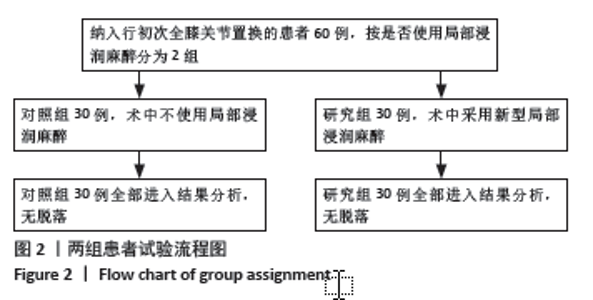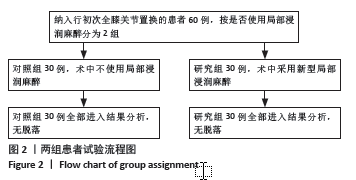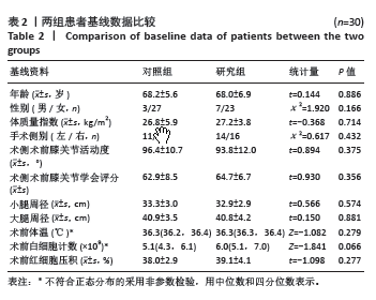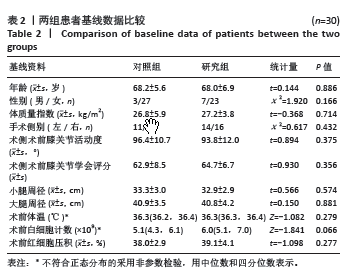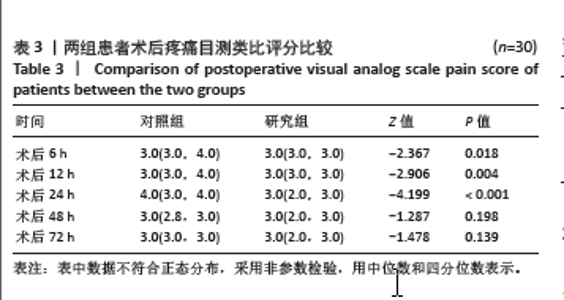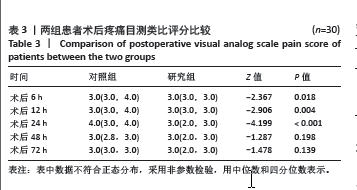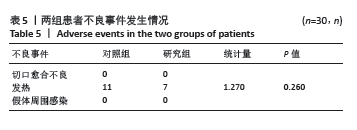Chinese Journal of Tissue Engineering Research ›› 2025, Vol. 29 ›› Issue (27): 5839-5844.doi: 10.12307/2025.850
Previous Articles Next Articles
Assessment on initial effectiveness of a novel local infiltration anesthesia in total knee arthroplasty
Wang Jun, Zhang Hui, Li Zhengyuan, Hao Lin, Chen Shenghong, Yin Zongsheng
- Department of Joint Surgery, First Affiliated Hospital of Anhui Medical University, Hefei 230022, Anhui Province, China
-
Received:2024-07-25Accepted:2024-09-26Online:2025-09-28Published:2025-03-05 -
Contact:Yin Zongsheng, MD, Chief physician, Professor, Department of Joint Surgery, First Affiliated Hospital of Anhui Medical University, Hefei 230022, Anhui Province, China -
About author:Wang Jun, MD, Attending physician, Department of Joint Surgery, First Affiliated Hospital of Anhui Medical University, Hefei 230022, Anhui Province, China -
Supported by:Anhui Natural Science Foundation, No. 2308085MH250 (to WJ); Anhui Provincial College Natural Science Foundation, No. 2023AH053327 (to WJ)
CLC Number:
Cite this article
Wang Jun, Zhang Hui, Li Zhengyuan, Hao Lin, Chen Shenghong, Yin Zongsheng. Assessment on initial effectiveness of a novel local infiltration anesthesia in total knee arthroplasty[J]. Chinese Journal of Tissue Engineering Research, 2025, 29(27): 5839-5844.
share this article
Add to citation manager EndNote|Reference Manager|ProCite|BibTeX|RefWorks

2.5 两组患者术后结局指标比较 在术后72 h内,所有患者均接受芬太尼透皮贴剂,换算后其相当于摄入吗啡毫克等效量为4.2 mg;在术后第3天,研究组患者的膝关节活动度为(102.5±11.5)°,优于对照组的(95.2±10.7)°,差异有显著性意义(P < 0.05);研究组患者术后KSS评分为(79.2±2.0)分,优于对照组的(74.9±2.2)分,差异有显著性意义(P < 0.05)。此外,两组患者的白细胞数量均较术前有所下降,并且研究组患者术后第3天的白细胞数量较对照组更低,差异有显著性意义(P < 0.05),表明研究组患者术后炎症程度较轻。但比较两组患者的总体失血量、隐性失血量及术后引流量,差异均无显著性意义(P > 0.05)。研究组患者术后的小腿围增加率较对照组低(P < 0.05),而大腿围增加率与对照组无明显变化(P > 0.05),见表4,表明研究组患者术后膝关节肿胀程度较对照组有所减轻。"
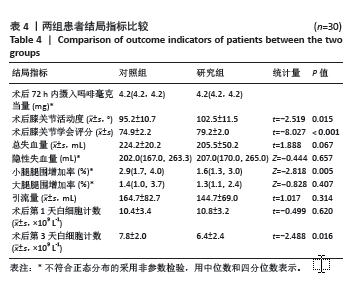
| [1] HAWKER GA, BOHM E, DUNBAR MJ, et al. The Effect of Patient Age and Surgical Appropriateness and Their Influence on Surgeon Recommendations for Primary TKA: A Cross-Sectional Study of 2,037 Patients. J Bone Joint Surg Am. 2022;104(8):700-708. [2] DOWSEY MM, BROWN WA, COCHRANE A, et al. Effect of Bariatric Surgery on Risk of Complications After Total Knee Arthroplasty: A Randomized Clinical Trial. JAMA Netw Open. 2022;5(4):e226722. [3] HUSTED CE, HUSTED H, INGELSRUD LH, et al. Are functional outcomes and early pain affected by discharge on the day of surgery following total hip and knee arthroplasty? Acta Orthop. 2021;92(1):62-66. [4] THIENGWITTAYAPORN S, TANGTRAKUL P, HONGKU N, et al. Patellar Denervation Reduces Postoperative Anterior Knee Pain After Patellar Resurfacing Total Knee Arthroplasty: A Randomized Controlled Trial. J Arthroplasty. 2021;36(4):1295-1301. [5] SUMMERS S, MOHILE N, MCNAMARA C, et al. Analgesia in Total Knee Arthroplasty: Current Pain Control Modalities and Outcomes. J Bone Joint Surg Am. 2020;102(8):719-727. [6] AVELINE C, FUZIER R, LUPESCU R, et al. A prospective multicentre observational study on perioperative analgesia practices for total knee arthroplasty in France: the KNEEONE survey. Br J Anaesth. 2020;124(2): e26-e28. [7] LI Z, LI Z, CHENG K, et al. The Efficacy and Safety of Glucocorticoid on Periarticular Infiltration Analgesia in Total Knee Arthroplasty: A Systematic Review and Meta-Analysis of Randomized Controlled Trials. J Arthroplasty. 2021;36(9):3340-3350. [8] FAN L, YU X, ZAN P, et al. Comparison of Local Infiltration Analgesia With Femoral Nerve Block for Total Knee Arthroplasty: A Prospective, Randomized Clinical Trial. J Arthroplasty. 2016;31(6):1361-1365. [9] NAKAGAWA S, ARAI Y, INOUE H, et al. Comparative Effects of Periarticular Multimodal Drug Injection and Single-Shot Femoral Nerve Block on Pain Following Total Knee Arthroplasty and Factors Influencing Their Effectiveness. Knee Surg Relat Res. 2016;28(3):233-238. [10] DAVIES AF, SEGAR EP, MURDOCH J, et al. Epidural infusion or combined femoral and sciatic nerve blocks as perioperative analgesia for knee arthroplasty. Br J Anaesth. 2004;93(3):368-374. [11] TIERNEY E, LEWIS G, HURTIG JB, et al. Femoral nerve block with bupivacaine 0.25 per cent for postoperative analgesia after open knee surgery. Can J Anaesth. 1987;34(5):455-458. [12] LI WT, BELL KL, YAYAC M, et al. A Postdischarge Multimodal Pain Management Cocktail Following Total Knee Arthroplasty Reduces Opioid Consumption in the 30-Day Postoperative Period: A Group-Randomized Trial. J Arthroplasty. 2021;36(1):164-172. [13] ROSS JA, GREENWOOD AC, SASSER PR, et al. Periarticular Injections in Knee and Hip Arthroplasty: Where and What to Inject. J Arthroplasty. 2017;32(9S):S77-S80. [14] ZHANG Z, YANG Q, XIN W, et al. Comparison of local infiltration analgesia and sciatic nerve block as an adjunct to femoral nerve block for pain control after total knee arthroplasty: A systematic review and meta-analysis. Medicine (Baltimore). 2017;96(19):e6829. [15] LI J, DENG X, JIANG T. Combined femoral and sciatic nerve block versus femoral and local infiltration anesthesia for pain control after total knee arthroplasty: a meta-analysis of randomized controlled trials. J Orthop Surg Res. 2016;11(1):158. [16] 郑华, 陈超, 郭珊娜, 等. 氢吗啡酮在骨科术后镇痛中应用的有效性和安全性[J]. 临床外科杂志,2016,24(1):68-70. [17] MOHNEY N, WILLIAMSON CA, ROTHMAN E, et al. A Propensity Score Analysis of the Impact of Dexamethasone Use on Delayed Cerebral Ischemia and Poor Functional Outcomes After Subarachnoid Hemorrhage. World Neurosurg. 2018;109:e655-e661. [18] LAVAND’HOMME PM, GROSU I, FRANCE MN, et al. Pain trajectories identify patients at risk of persistent pain after knee arthroplasty: an observational study. Clin Orthop Relat Res. 2014;472(5):1409-1415. [19] KIM JI, KIM YT, JUNG HJ, et al. Does adding corticosteroids to periarticular injection affect the postoperative acute phase response after total knee arthroplasty? Knee. 2020;27(2):493-499. [20] KULKARNI M, MALLESH M, WAKANKAR H, et al. Effect of Methylprednisolone in Periarticular Infiltration for Primary Total Knee Arthroplasty on Pain and Rehabilitation. J Arthroplasty. 2019;34(8):1646-1649. [21] LUTSKY KF, LUCENTI L, BANNER L, et al. The Effect of Intraoperative Corticosteroid Injections on the Risk of Surgical Site Infections for Hand Procedures. J Hand Surg Am. 2019;44(10):840-845. [22] ZHAO X, QIN J, TAN Y, et al. Efficacy of steroid addition to multimodal cocktail periarticular injection in total knee arthroplasty: a meta-analysis. J Orthop Surg Res. 2015;10:75. [23] 黄龙, 林世清, 周雪. 帕瑞昔布钠与氟比洛芬酯对重症肌无力患者的术后镇痛效果比较[J]. 实用医学杂志,2013,29(8):1335-1337. [24] WANG L, WU LX, HAN Z, et al. Effect of flurbiprofen axetil combined with “Cocktail” therapy on opioid dosage in patients after total knee arthroplasty. Pak J Med Sci. 2022;38(3Part-I):724-729. [25] KUANG MJ, XU LY, MA JX, et al. Adductor canal block versus continuous femoral nerve block in primary total knee arthroplasty: A meta-analysis. Int J Surg. 2016;31:17-24. [26] LUO Z, ZENG W, CHEN X, et al. Cocktail of Ropivacaine, Morphine, and Diprospan Reduces Pain and Prolongs Analgesic Effects after Total Knee Arthroplasty: A Prospective Randomized Controlled Trial. Int J Clin Pract. 2024;2024:3697846. [27] 吴常, 闫帮楷, 李英祥, 等. 单髁置换术与全膝关节置换术治疗膝骨关节炎的早期疗效评价[J]. 医学信息,2024,37(8):109-113. [28] 李小林, 柳晓峰, 王朝君, 等. 单髁与全膝关节置换术治疗膝关节骨性关节炎的效果[J]. 中国临床研究,2024,37(5):767-772. [29] GROSS JB. Estimating allowable blood loss: corrected for dilution. Anesthesiology. 1983;58(3):277-280. [30] 汪萧和, 王志文, 陆鸣, 等. 两种止血带使用方式对150例全膝关节置换术患者失血量和术后康复影响的前瞻性随机对照研究[J]. 中华骨与关节外科杂志,2020,13(9):736-740. [31] 李正远, 郝琳, 陈圣洪, 等. 局部应用万古霉素预防全膝关节置换切口早期感染[J]. 中国组织工程研究,2024,28(33):5346-5350. [32] PARVIZI J, TAN TL, GOSWAMI K, et al. The 2018 Definition of Periprosthetic Hip and Knee Infection: An Evidence-Based and Validated Criteria. J Arthroplasty. 2018;33(5):1309-1314. [33] 张念军, 陈茹. 全膝关节置换过程中鸡尾酒疗法联合股神经阻滞的镇痛效果[J]. 中国组织工程研究,2021,25(6):866-872. [34] WANG X, WANG Y, HU Y, et al. Effect of flurbiprofen axetil on postoperative delirium for elderly patients. Brain Behav. 2019;9(6):e1290. [35] XIANG X, YUAN X, LIAN Y, et al. Effect of oxycodone hydrochloride combined with flurbiprofen axetil for intravenous patient-controlled analgesia in lower abdominal patients: A randomized trial. Medicine (Baltimore). 2018; 97(7):e9911. [36] CANOVAS F, DAGNEAUX L. Quality of life after total knee arthroplasty. Orthop Traumatol Surg Res. 2018;104(1S):S41-S46. [37] PREVITALI D, DI LAURA FG, FILARDO G, et al. Peri-operative steroids reduce pain, inflammatory response and hospitalisation length following knee arthroplasty without increased risk of acute complications: a meta-analysis. Knee Surg Sports Traumatol Arthrosc. 2021;29(1):59-81. [38] LI Q, MU G, LIU X, et al. Efficacy of additional corticosteroids to multimodal cocktail periarticular injection in total knee arthroplasty: a meta-analysis of randomized controlled trials. J Orthop Surg Res. 2021;16(1):77. [39] HANGODY L, SZODY R, LUKASIK P, et al. Intraarticular Injection of a Cross-Linked Sodium Hyaluronate Combined with Triamcinolone Hexacetonide (Cingal) to Provide Symptomatic Relief of Osteoarthritis of the Knee: A Randomized, Double-Blind, Placebo-Controlled Multicenter Clinical Trial. Cartilage. 2018;9(3):276-283. [40] AKARAVINEK P, KAMPITAK W, TANAVALEE A, et al. Effect of Adding Perineural Methylprednisolone to Peripheral Nerve Blocks Combined With Intravenous Dexamethasone for Prolonged Postdischarge Analgesia After Fast-track Total Knee Arthroplasty: A Randomized Controlled Trial. Clin J Pain. 2023; 39(4):180-187. [41] LUNN TH, KEHLET H. Perioperative glucocorticoids in hip and knee surgery - benefit vs. harm? A review of randomized clinical trials. Acta Anaesthesiol Scand. 2013;57(7):823-834. [42] XING LZ, LI L, ZHANG LJ. Can intravenous steroid administration reduce postoperative pain scores following total knee arthroplasty: A meta-analysis. Medicine (Baltimore). 2017;96(24):e7134. [43] CHAN V, CHAN PK, FU H, et al. Combination Effect of High-Dose Preoperative and Periarticular Steroid Injection in Total Knee Arthroplasty. A Randomized Controlled Study. J Arthroplasty. 2021;36(1):130-134. [44] ISAAC D, FALODE T, LIU P, et al. Accelerated rehabilitation after total knee replacement. Knee. 2005;12(5):346-350. [45] 戴繁林, 李刚, 王小武, 等. 全膝关节置换术中膝关节容积率与术后早期膝关节活动度的相关性研究[J]. 中国骨与关节损伤杂志,2019, 34(12):1249-1252. [46] AF KE, GRUNDTMAN C, ENGSTROM M, et al. Intraarticular glucocorticoid treatment reduces inflammation in synovial cell infiltrations more efficiently than in synovial blood vessels. Arthritis Rheum. 2005;52(12):3880-3889. [47] 卫生部. 糖皮质激素类药物临床应用指导原则[J]. 实用防盲技术,2012, 7(1):38-45, 19. [48] WILLIAMS BA, HOUGH KA, TSUI BY, et al. Neurotoxicity of adjuvants used in perineural anesthesia and analgesia in comparison with ropivacaine. Reg Anesth Pain Med. 2011;36(3):225-230. [49] MA R, WANG X, LU C, et al. Dexamethasone attenuated bupivacaine-induced neuron injury in vitro through a threonine-serine protein kinase B-dependent mechanism. Neuroscience. 2010;167(2):329-342. |
| [1] | Zhou Jinhai, Li Jiangwei, Wang Xuquan, Zhuang Ying, Zhao Ying, Yang Yuyong, Wang Jiajia, Yang Yang, Zhou Shilian. Three-dimensional finite element analysis of anterior femoral notching during total knee arthroplasty at different bone strengths [J]. Chinese Journal of Tissue Engineering Research, 2025, 29(9): 1775-1782. |
| [2] | Su Dejun, Dong Wanpeng, Dong Yuefu, Zhang Jichao, Zhang Zhen. Design of asymmetric prosthesis and mechanical analysis of total knee arthroplasty [J]. Chinese Journal of Tissue Engineering Research, 2025, 29(3): 510-516. |
| [3] | Wang Yijun, Zheng Kai, Zhang Lianfang, Zhu Feng, Zhang Weicheng, Li Rongqun, Zhou Jun, Xu Yaozeng. Navigation-assisted total knee arthroplasty using functional alignment restores constitutional alignment and joint line obliquity [J]. Chinese Journal of Tissue Engineering Research, 2025, 29(27): 5810-5818. |
| [4] | Zhang Yilong, Wu Wanling, Yang Wenwu, Wu Hongtao, Liu Wengang, He Minyi, Zhao Chuanxi. Correlation between preoperative knee extensor and flexor muscle strength and postoperative gait function in total knee arthroplasty [J]. Chinese Journal of Tissue Engineering Research, 2025, 29(27): 5819-5825. |
| [5] | Ding Yuan, Gong Jianbao, Zhang Jie, Qiao Yuan, Xu Wenlong. Characteristic analysis of isometric muscle strength of knee joint in patients after unicompartmental knee arthroplasty [J]. Chinese Journal of Tissue Engineering Research, 2025, 29(27): 5833-5838. |
| [6] | Sun Hailiang, Pang Jian, Shi Wanzhong, Shi Ying. Protective effect of Huaizhen Yanggan Capsule on knee osteoarthritis induced by sodium iodoacetate in model mice [J]. Chinese Journal of Tissue Engineering Research, 2025, 29(26): 5579-5587. |
| [7] | Wang Yuning, Zhu Haotian, Liu Kang, Ding Huanwen, Yan Han. Comparison of short-term therapeutic effects between digital precision total knee arthroplasty and traditional methods [J]. Chinese Journal of Tissue Engineering Research, 2025, 29(21): 4521-4528. |
| [8] | Xu Minglan, Hu Xiaoxue, Shen Jun, Xiang Zheng, Zhang Chengbo, Xiao Lianbo. Opposing needling acupuncture combined with preemptive analgesia in treatment of pain after initial unilateral total knee arthroplasty [J]. Chinese Journal of Tissue Engineering Research, 2025, 29(21): 4529-4536. |
| [9] | Zhao Liping, Chen Yibo, Wang Yaqian, Li Zhitong, Zhang Qi, Gou Bo. Mechanism of central analgesia in rats with myofascial pain syndrome by intervention of “trigger points” with stagnant moving needles [J]. Chinese Journal of Tissue Engineering Research, 2025, 29(17): 3614-3623. |
| [10] | Pan Hao, Yang Meng, Liu Guoqiang. Timing of total knee arthroplasty with tourniquet under navigation system: a single-center, retrospective analysis [J]. Chinese Journal of Tissue Engineering Research, 2025, 29(15): 3159-3164. |
| [11] | Shan Jiaxin, Zhang Yilong, Wu Hongtao, Zhang Jiayuan, Li Anan, Liu Wengang, Xu Xuemeng, Zhao Chuanxi. Changes in muscle strength and pain in patients receiving Jianpi Yiqi Huoxue Formula after total knee arthroplasty [J]. Chinese Journal of Tissue Engineering Research, 2024, 28(9): 1378-1382. |
| [12] | Qi Haodong, Lu Chao, Xu Hanbo, Wang Mengfei, Hao Yangquan. Effect of diabetes mellitus on perioperative blood loss and pain after primary total knee arthroplasty [J]. Chinese Journal of Tissue Engineering Research, 2024, 28(9): 1383-1387. |
| [13] | Li Xiaoqiang, Chen Wei, Li Mingyue, Shan Tianchi, Shen Wen. Value of preoperative quantitative ultrasound analysis of quadriceps femoris in predicting chronic post-surgical pain after total knee arthroplasty [J]. Chinese Journal of Tissue Engineering Research, 2024, 28(9): 1388-1393. |
| [14] | Wang Tihui, Wang Xu, Wu Jinqing, Chen Jiliang, Wang Xiaolu, Miao Juan. Application of three-dimensional simulated osteotomy of the distal femur in total knee arthroplasty [J]. Chinese Journal of Tissue Engineering Research, 2024, 28(6): 905-910. |
| [15] | Yang Yifeng, Huang Jian, Ye Nan, Wang Lin. Ischemia-reperfusion injury in total knee arthroplasty [J]. Chinese Journal of Tissue Engineering Research, 2024, 28(6): 955-960. |
| Viewed | ||||||
|
Full text |
|
|||||
|
Abstract |
|
|||||
